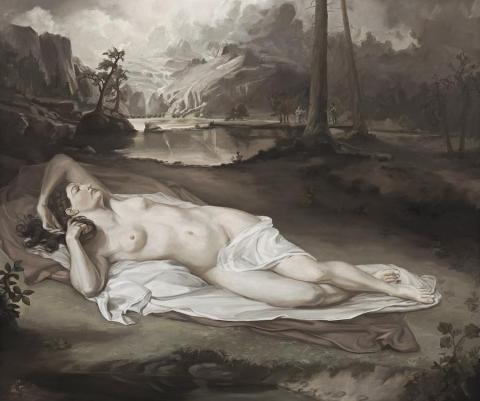THE NATURE OF A BAR PAINTING, 1988
STEPHEN BUSH
oil on canvas
167.0 x 198.0 cm
signed, dated and inscribed verso on stretcher: “The nature of bar painting” / Stephen Bush 1988
Powell Street Gallery, Melbourne
The John L. Stewart Collection, New York
Stephen Bush, Powell Street Gallery, Melbourne, 1989 (label attached verso)
The Nature of a Bar Painting, 1988 calls to mind a host of art historical references. Most notably, this work refers to an infamous oil painting by French artist Gustave Courbet entitled La Femme au perroquet (Woman with a Parrot), housed in the Metropolitan Museum of Art, New York. This painting depicted a nude woman in almost the same pose as our lady in The Nature of a Bar Painting, lounging seductively with her hair sprawled out behind her in a dishevelled fashion. La Femme au perroquet aroused great controversy when it was accepted by the Paris Salon in 1866 as it was considered by many to be indecent.
Undoubtedly the nude portrait of a beautiful young woman, Chloe,by Jules Lefebvre, also impressed upon Bush when painting this work. Chloe is Melbourne's most revered bar painting, acquired by Young and Jacksons hotel in 1908 after a controversial exhibition history, the work having been withdrawn from exhibition at the National Gallery of Victoria in 1883. This painting captured the imagination of Australians in the 19th and early 20th centuries, with nude paintings of women becoming ubiquitous at that time in bars throughout Australia.
Bush's painting, however, is not quite so earnest; hints of the absurd haunt this image. The Nature of a Bar Painting presents a voluptuous, nude woman, reclining lasciviously in the foreground of some incongruous remote setting. The landscape is ruggedly Australian, and two small figures in the background watch the naked woman furtively while chopping down a tree. Perhaps they are wondering who this woman is, and why she is lounging here, of all places, in the middle of the wilderness. Unlike Lefebvre's Chloe, or Courbet's Woman with a Parrot, there is something staged and a little ridiculous about the composition of our work.
Bush completed numerous paintings in monochrome palettes through the 1980s and 90s, most often in Venetian red, black and white, or purple. In these works Bush tests the assumption that photography or any other type of purportedly objective documentation could in fact be just that: objective. Bush's monochromatic paintings always strive to tell a historical story, but they also make explicit that the telling of any story through art or journalism is at best, propaganda.
LEAH CROSSMAN
